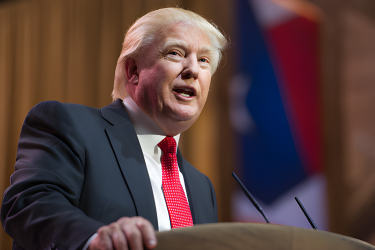The sun is setting on Donald Trump’s first 100 days of his second term as President. Now that stock markets in the US have closed, we can confirm that the S&P 500 has experienced its worst performance during a President’s first 100 days for more than 50 years. Only President Nixon’s second term in office saw a worse performance for the US stock market, as you can see in the chart below. The S&P500 has fallen more than 7% since Trump took office on January 20, wiping more than $4 trillion from the benchmark index.
Chart 1:

Source: XTB
The performance could have been worse, at one point the S&P 500 had fallen by more than 16% during Trump’s first 100 days in office. Trump has been saved from the humiliation of having the worst performance of any President since before 1969, by a recovery in US stock markets in the last two weeks.
The drop in US stocks has come as tariffs, changes in the Artificial Intelligence market and a possible recession have prompted investors to pull funds from the listed markets. President Trump’s unorthodox approach to economic policy has had a major impact on financial market sentiment. This has caused historical moves in US stocks, that have not been seen for 50 years.
There is still a long way to go in President Trump’s second term but the verdict from the stock market to date has been mostly negative. There are now concerns the US economy could dip into recession this year, a downturn that has the potential to impact other economies globally.
The fall in US markets contrasts with the performance of other major indices, with markets in Europe outperforming US stocks over the same time period. The dollar has also fared poorly against most major currencies, falling more than 9% on a broad basis since Trump took office. The main losers in the selloff in US markets have been the tech giants that make up the Magnificent Seven. The chart below shows the total return performance of the largest US 500 companies, both with and without the Magnificent Seven. For most of this year, the Magnificent Seven has been a drag on the overall US index, which is a big change from last year.
Chart 2:

Source: XTB
Various factors are impacting investor sentiment, not least the growing sense that China may be on the cusp of mounting a real challenge to US dominance of the AI market. The launch of the Chinese large language model DeepSeek spooked the market and continues to create uncertainty about where and how the AI market will develop.
Overall, the first 100 days of President Trump’s second term in office has also been one of the most volatile on the public markets. ‘Liberation Day’ on April 2, when Trump announced his tariff policy, led to a severe downturn in the markets with the S&P500 dropping over 10% in just two days. While some of those losses were pared back, speculation that the President may try to fire the Chairman of the Federal Reserve led to similar, if less pronounced, swings in the market.
While day traders will be enjoying the volatility, long term investors will be less impressed. However, we can all take comfort from the underlying economic data which suggests that the US economy is weathering the current turmoil in the markets and remains strong, giving hope to those looking for a return to more normal conditions.
Daily Summary: End of the week in the red, tech rally waning
Three Markets to Watch Next Week (12.12.2025)
Rivian Automotive: Rising star or a meteorite?
Technology companies declines 📉🖥️
This content has been created by XTB S.A. This service is provided by XTB S.A., with its registered office in Warsaw, at Prosta 67, 00-838 Warsaw, Poland, entered in the register of entrepreneurs of the National Court Register (Krajowy Rejestr Sądowy) conducted by District Court for the Capital City of Warsaw, XII Commercial Division of the National Court Register under KRS number 0000217580, REGON number 015803782 and Tax Identification Number (NIP) 527-24-43-955, with the fully paid up share capital in the amount of PLN 5.869.181,75. XTB S.A. conducts brokerage activities on the basis of the license granted by Polish Securities and Exchange Commission on 8th November 2005 No. DDM-M-4021-57-1/2005 and is supervised by Polish Supervision Authority.


